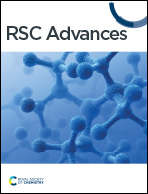High-purity C3N quantum dots for enhancing fluorescence detection of metal ions†
Abstract
A new type of two-dimensional layered material, namely C3N, has been fabricated by polymerization and recommended to have great potential in various applications such as the development of electronic devices or photo-detectors, due to its enhanced conductivity, electronegativity, and unique optical properties. Actually, most of the present research on C3N is limited in the scope of theoretical calculation, while experimental research is blocked by inefficient synthesis with low purity and homogeneity. Here, we report an optimized efficient synthesis method of high-purity C3N QDs in aqueous solution by polymerization of DAP with combined centrifugation and filtration of products, with the synthesis yield up to 33.1 ± 3.1%. Subsequently, the C3N QDs have been used as novel metal ion probes exhibiting a sensitive fluorescent response to various metal ions including monovalent alkaline metals (Li+, Na+, and K+), divalent alkaline-earth metals (Mg2+, Ca2+, and Sr2+), and multivalent transition metals (Cu2+, Co2+, Ni2+, and Au3+, Fe3+, Cr3+) due to the high electronegativity of the C3N surface. Particularly, the fluorescent quenching response of Al3+, Ga3+, In3+, and Sc3+ ions is significantly different from the fluorescent enhanced response of most other carbon-based QDs, which is promising for enriching the detection methods of these metal ions and beneficial to improve the accuracy of ion recognition.



 Please wait while we load your content...
Please wait while we load your content...